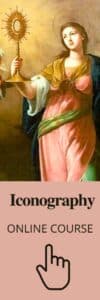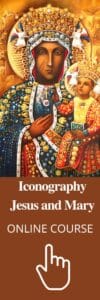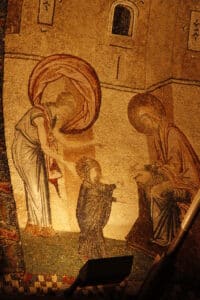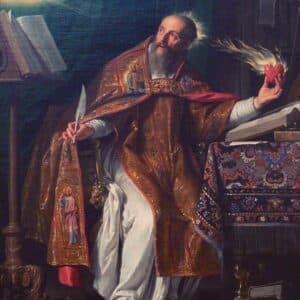Iconography Course Online
Citaliarestauro now offers several courses in the field of iconography. This is because art analysis is one of the areas that particularly interests us.
Each iconography course online focuses on a specific context, period, and cultural framework. This is because iconography as a method of art analysis aims to decipher specific symbols and icons from a given social and cultural context, that is, it deciphers a language and a particular form of communication.
Why is iconography important in the analysis of works of art?
Let’s take an example
From the beginning, Christianity has used symbols to tell the stories of saints and martyrs.
As a means of educating the faithful, who generally could not read, saints were identified with an iconic motif associated with their lives, called an attribute.
The same is true of the representation of episodes from their lives: there are symbols and actions that provide the context that allows them to be identified.
Scientific approach in the field of art history
In the course of art history studies, a whole scientific approach to the iconographic reading of these attributes has developed, which has been called iconography—the study of icons.
Iconography is thus a form of visual communication that uses images to represent something. It is generally used in the analysis of works of art, relating sources and meanings.
Icons and symbols vary across different cultures, societies, and eras.
For example, the Egyptian god Anubis—god of funeral rites, death, the dead, and the afterlife, and protector of the necropolises—was represented as a man with the head of a jackal or dog, or as a lying jackal or dog.
This attribute allows us to immediately identify his representation.

Iconography course online at Citaliarestauro
In an online iconography course at Citaliarestauro, you can learn:
Iconography course Online – Iconography of the Saints
You will learn, for example, how to identify the Tetramorph
This is one of the representations found in Christian art.
It represents the Four Evangelists. They have a particularly rich and distinctive iconography due to their participation in the production of the Bible.
What is Tetramorph?
These have a particularly rich iconography, due to their participation in the production of the Bible. So, over time, they can be represented as individuals or as a group, in a very interesting format.
We can identify, firstly, God in the First Person (centered), distinguished by his triangular nimbus (symbolical of the Holy Trinity). He is surrounded by three animals and, facing him, an Angel. Knowing the Gospel, we can realize that God is in fact surrounded by the Four Evangelists. These often appear represented not only as the men they were, bearing certain objects as their attributes, but also as animals (and an Angel, in the case of St. Matthew), symbolism related directly to the Gospels of Christ.
The reason for these representations
Thus, this form of representation, called Tetramorphos (from Greek tetra: four, and morpho: shape), will replace the traditional image of these Apostles, stressing their importance in spreading the Word of God through the Gospels.
The Tetramorphos consists of an Angel, a Lion, a Bull and an Eagle. These representations are directly linked to the corresponding Gospel of each Apostle, like so:
– the Angel (or a Man) represents St. Matthew, who defended the humanity of Christ through his testimony. St. Matthew symbolizes the Birth and must be placed to the right of Christ/God;
– the Lion represents St. Marc, because his Gospel begins with the prediction of John the Baptist («the voice that cried from the desert»). It symbolizes the Resurrection and is also placed at the right hand of Christ;
– the Bull represents St. Luke, who speaks of the sacrifice of Zechariah, father of John the Baptist (the animal chosen for the sacrifices was, generally, the bull). Furthermore, St. Luke speaks extensively about the sacrifice of Jesus on the cross, thus symbolizing the Passion of Christ. He is located to the left of Christ;
– the Eagle represents St. John, which begins his Gospel in the sky, focusing on the spiritual. Also, according to the bestiary, the Eagle is the only animal that can face the Sun, which in this case is symbolic of the Divine Person. The Eagle is represented on the left, above the Bull.
In addition to the Tetramorphos, these Apostles can be presented simply sitting or writing their Gospels, alongside with their symbolic animal. Sometimes, an Angel seems to whisper in St. Matthew’s ear.
![]()
Iconography Course Online – Iconography of Jesus and Mary
In this Iconography Course Online which focuses on representations of Jesus and Mary in art, you will learn to analyze and interpret
At the end of this iconography course online participants will be able to apply methods of iconographic analysis and learn about the episodes from the lives of Jesus and Mary most commonly represented in works of art, with practical exercises and materials for future use.
In this iconography course online you will analyze a little-known episode in the life of Mary:
the Seven Steps of Mary, a rare scene in Western iconography and more common in Byzantine iconography.
This is an episode from her childhood in which it is said that, when she was only six months old, Anne stood Mary up to see if she could walk, and Mary took seven steps to her mother’s lap. Anna then realizes how Mary is truly a gift from God, and Mary is sent to the Temple in Jerusalem to be educated.
The message to be conveyed is precisely this: proof of the merit and dignity of the woman who will be the mother of Jesus, instilling this in the faithful who observe her example.

The Seven Steps of Mary. 13th-century mosaic in the Church of the Savior in Chora, Constantinople (Turkey).

